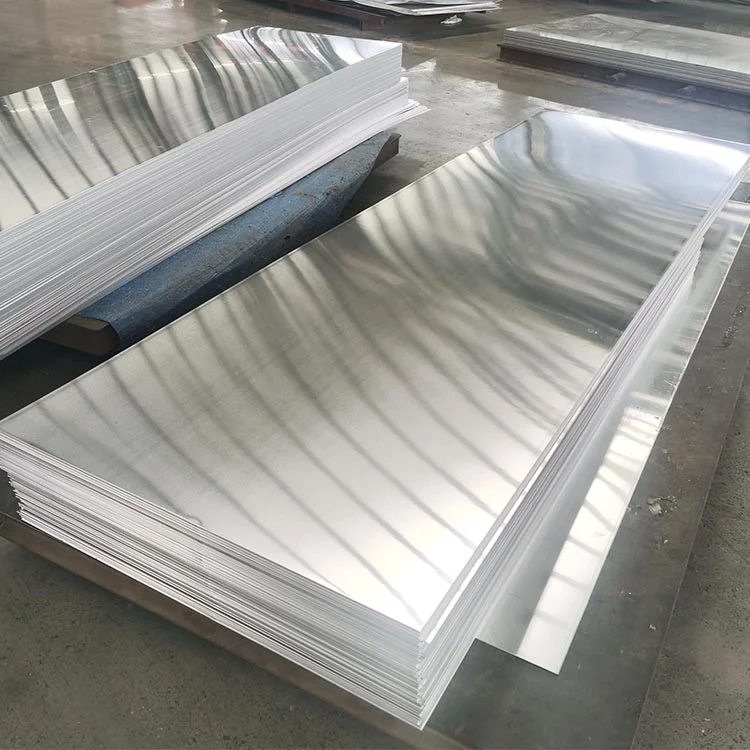Pipe jacketing is a crucial process in various industries that involves insulating and protecting pipes by adding an outer covering or jacket. It serves multiple purposes, including thermal insulation, corrosion protection, mechanical strength, aesthetic enhancement, and weatherproofing. Pipe jacketing plays a vital role in maintaining the efficiency, integrity, and longevity of piping systems in diverse applications.

Definition of Pipe Jacketing
Pipe jacketing refers to the application of an exterior covering or jacket to pipes in order to provide insulation, protect against corrosion, enhance aesthetics, or offer mechanical protection.
Importance of Pipe Jacketing
Pipe jacketing is important for several reasons. It helps prevent heat loss or gain in pipes, ensuring energy efficiency and maintaining the desired temperature of the fluid or gas flowing through the pipe. It also protects pipes from corrosion caused by moisture, chemicals, or environmental factors, thus extending their lifespan. Furthermore, pipe jacketing enhances the appearance of pipes in architectural applications and provides mechanical strength and weather resistance.

Benefits of Pipe Jacketing
- Thermal Insulation: Pipe jacketing provides a layer of insulation that reduces heat transfer, minimizing energy losses and maintaining the desired temperature of the fluid or gas inside the pipe.
- Energy Efficiency: By preventing heat loss or gain, pipe jacketing contributes to energy conservation and cost savings in heating, ventilation, air conditioning, and other thermal systems.
- Resistenza alla corrosione: Jacketing materials such as aluminum, stainless steel, and PVC act as a protective barrier, shielding pipes from corrosion caused by moisture, chemicals, or harsh environments.
- Mechanical Protection: Pipe jacketing offers mechanical strength and protection, safeguarding pipes from external impacts, abrasion, or potential damage in industrial settings or areas with high traffic.
- Aesthetic Enhancement: Pipe jacketing materials like stainless steel, aluminum, or PVC with various finishes and colors can improve the aesthetic appearance of pipes, making them suitable for architectural or building applications.
- Weatherproofing: Weatherproof jacketing materials protect pipes from exposure to UV radiation, rain, snow, extreme temperatures, or other weather conditions, particularly in outdoor or rooftop installations.
- Longevity and Durability: Pipe jacketing helps extend the lifespan of pipes by providing a protective layer that enhances their resistance to various factors, including corrosion, mechanical stress, and weathering.

Materials Used in Pipe Jacketing
Based on the particular needs of the application, various materials are used for pipe jacketing. The selection of a material is influenced by a variety of elements, including insulating qualities, corrosion resistance, mechanical strength, aesthetics, and financial constraints.
Insulation Materials
The primary function of insulation materials is thermal insulation, which reduces heat transmission and maintains temperature control in pipes. In pipe jacketing, the following insulation materials are frequently used:

- Fiberglass: Fiberglass insulation is inexpensive, lightweight, and has superior thermal insulating qualities. It is frequently used in refrigeration systems, hot water pipes, and HVAC systems.
- Mineral Wool: Mineral wool insulation provides good thermal insulation and sound absorption properties. It is fire-resistant and widely used in industrial applications where high-temperature insulation is required.
- Foam: Foam insulation, such as polyurethane or polyethylene foam, offers excellent thermal insulation and can be easily applied to pipes of various sizes and shapes. It is commonly used in both commercial and residential applications.
- Cellular Glass: Cellular glass insulation is made from crushed glass and offers excellent thermal insulation properties along with resistance to moisture and chemicals. It is often used in cryogenic applications or where high-temperature insulation is required.
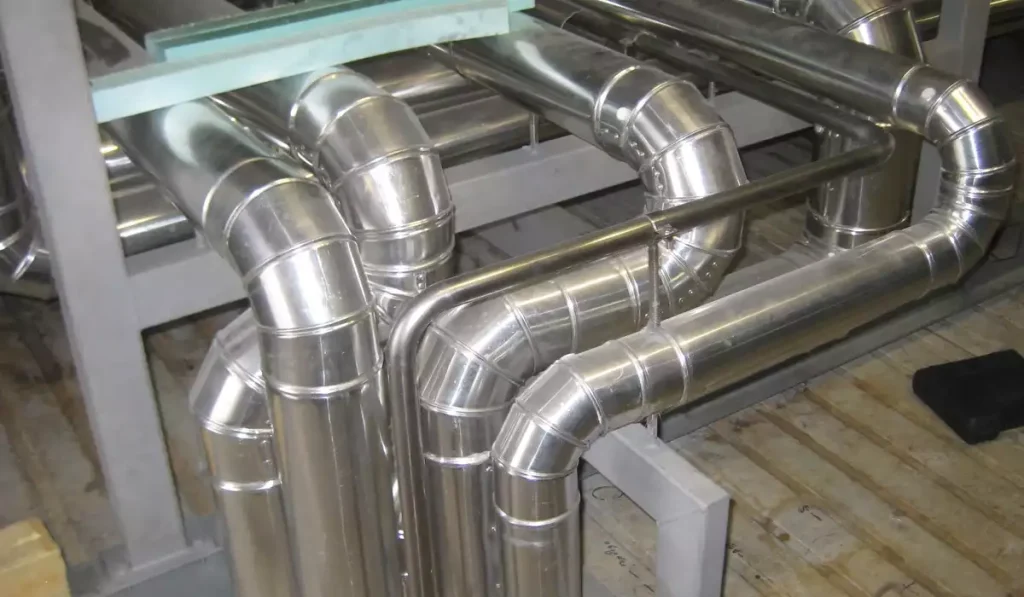
Corrosion Protection Materials
To protect pipes from corrosion brought on by moisture, chemicals, or the environment, jacketing materials are utilized. The following materials are frequently used in pipe jacketing to prevent corrosion:
- Aluminum: Aluminum jacketing is strong, lightweight, and offers outstanding corrosion resistance. Industrial settings, automation industry, construction industry, chemical facilities, oil and gas pipelines, and marine applications all frequently use it.
- Stainless Steel: Stainless steel jacketing offers superior corrosion resistance compared to other materials. It is particularly suitable for highly corrosive environments or applications where hygiene and cleanliness are essential.
- PVC: PVC jacketing is a cost-effective option that provides good corrosion resistance and is easy to install. It is commonly used in commercial buildings, HVAC systems, and applications where aesthetics are not a primary concern.

Aesthetic Materials
In architectural or building applications, aesthetic jacketing materials are typically employed for decorative purposes to improve the appearance of pipes. The following materials are frequently used in pipe jacketing for aesthetic reasons:
- Stainless steel: Stainless steel jacketing has a streamlined, contemporary appearance that makes it ideal for high-end architectural applications. It offers longevity, resistance to corrosion, and simplicity in maintenance.
- Aluminum: Aluminum jacketing is lightweight, adaptable, and accessible in a range of hues and finishes. It provides a modern appearance and is frequently utilized in commercial structures, hotels, restaurants, and public areas.
- PVC: For pipe jacketing applications, PVC jacketing in a variety of textures, designs, or hues can be employed to provide a pleasing look. When certain design requirements must be addressed or when cost-effective solutions are required, it is frequently adopted.

Mechanical Protection Materials
Pipes are physically shielded by mechanical protection jacketing materials from collisions, abrasion, and mechanical harm. The following materials are frequently used in pipe jacketing as mechanical protection:
- PVC: PVC jacketing that has been thickened or has layers that have been reinforced offers mechanical strength and defense against impacts or abrasion. It is frequently utilized in industrial settings, underground plumbing systems, or high traffic regions.
- Aluminum: Aluminum offers good mechanical strength and durability for jacketing. It is frequently chosen for applications where pipes are subject to external tension or possible damage. By the way, Lega di alluminio 3003 can be used as piping material, which has both good forming properties, high corrosion resistance and good weldability of parts components, but also higher strength than 1000 series alloys. However, the 1000 series of aluminum materials are cheap and relatively soft, mainly used for decorative or interior parts.
- Stainless steel: Jacketing made of stainless steel is more durable and resistant to mechanical harm. It is appropriate for applications in which pipelines need strong protection.

Climate-Resistant Materials
Pipes can be shielded from exposure to damaging weather elements including UV radiation, rain, snow, or extremely cold temperatures with weatherproof jacketing materials. The following materials are frequently used in pipe jacketing for weatherproofing:
- PVC: Weather-resistant PVC jacketing protects against UV rays and aids in preventing water intrusion. It is frequently utilized in rooftop installations or outdoor plumbing systems.
- Aluminum: Weather-resistant coatings or finishes on aluminum jacketing provide defense against corrosion and deterioration. It is frequently used in situations when pipes are exposed to the weather outside.
- Elastomeric Coatings: An elastomeric layer, such as one made of silicone or rubber, can be used as a weatherproofing layer. They offer adaptability, insulation, and defense against UV rays and extremely cold temperatures.
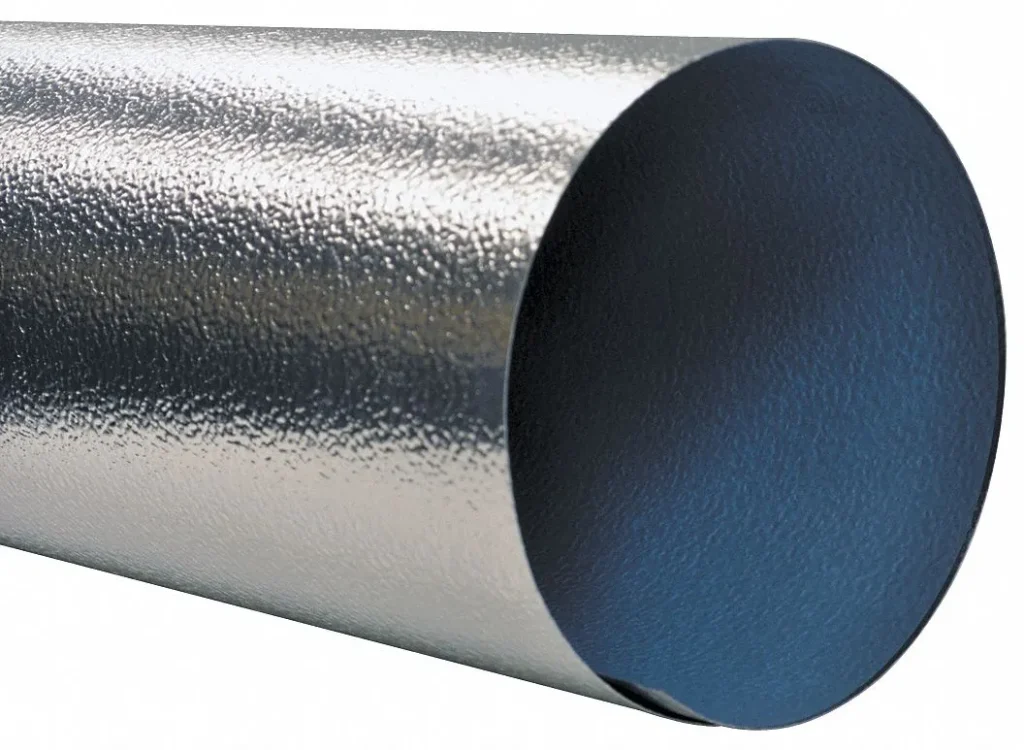
Advantages of Pipe Jacketing
Pipe jacketing is a crucial step in many sectors since it has a number of benefits. Making judgments on the use of pipe jacketing in certain applications can be made easier by being aware of these benefits. The following are the main benefits of pipe jacketing:
- Thermal Insulation: Thermal insulation is one of the main advantages of pipe jacketing. The temperature of the fluid or gas moving through the pipe can be kept at the correct level by greatly reducing heat transfer by adding an insulating layer to pipes. This helps heating, ventilation, air conditioning, and other thermal systems operate more efficiently and affordably.
- Energy Efficiency: Pipe jacketing is essential for energy efficiency and conservation. It aids in maintaining the proper temperature inside the pipe by minimizing heat gain or loss, which lessens the demand on heating or cooling systems. This results in decreased energy use and lower operational expenses.

- Resistenza alla corrosione: Another notable benefit of pipe jacketing is its resistance to corrosion. The pipe jacketing materials, which may be made of aluminum, stainless steel, or PVC, serve as a barrier to prevent corrosion brought on by moisture, chemicals, or harsh environments. The pipes last longer and require less regular maintenance or replacement as a result.
- Mechanical Protection: Pipe jacketing provides mechanical strength and protection to pipes, safeguarding them against external impacts, abrasion, or potential damage. This is particularly important in industrial settings or areas with high traffic or potential for impact. The jacketing materials like PVC, aluminum, or stainless steel with higher thickness or reinforced layers offer reliable mechanical protection.
- Aesthetic Enhancement: Pipe jacketing can improve pipes’ aesthetically pleasing appearance in architectural or construction applications. A visually pleasing design can be produced by selecting jacketing materials like stainless steel, aluminum, or PVC with a variety of coatings, textures, or colors. This qualifies it for use in commercial structures, lodging facilities, dining establishments, public areas, or any other setting where aesthetics are vital.
- Weather Protection: Weatherproof pipe jacketing materials protect pipes from exposure to harsh weather conditions such as UV radiation, rain, snow, extreme temperatures, or other environmental factors. Pipes installed in outdoor or rooftop settings are vulnerable to weather-related damage, and weatherproof jacketing ensures their durability and performance over time.
- Longevity and Durability: Pipe jacketing enhances the longevity and durability of pipes. The protective layer provided by the jacketing materials improves the resistance of pipes to corrosion, mechanical stress, and weathering. This helps in extending the lifespan of the pipes, reducing maintenance requirements, and ensuring long-term performance.

Application of Pipe Jacketing
Pipe jacketing has a wide range of applications across various industries and sectors. The versatility of pipe jacketing allows it to be used in different systems and environments. Here are some common applications of pipe jacketing:
- HVAC Systems: Pipe jacketing is extensively used in heating, ventilation, and air conditioning (HVAC) systems. It helps maintain thermal insulation, preventing heat loss or gain in pipes carrying hot or cold fluids. HVAC systems rely on pipe jacketing to ensure energy efficiency and optimal performance.
- Process Piping: Pipe jacketing is crucial in process piping systems, where it serves both thermal insulation and corrosion protection purposes. Process piping is commonly found in industries such as chemical processing, pharmaceuticals, food and beverage, and oil refineries.

- Refrigeration Systems: Pipe jacketing is essential in refrigeration systems, including those used in cold storage facilities, food processing plants, and supermarkets. It helps maintain the desired temperature and prevent condensation on the refrigeration pipes.
- Chemical Plants: Chemical plants involve the transportation of various chemicals through pipelines. Pipe jacketing with corrosion-resistant materials provides crucial protection against chemical exposure and ensures the integrity of the piping system.
- Oil and Gas Pipelines: Pipe jacketing is widely used in the oil and gas industry for both onshore and offshore pipelines. It protects the pipes from corrosion caused by exposure to moisture, chemicals, and harsh environmental conditions.
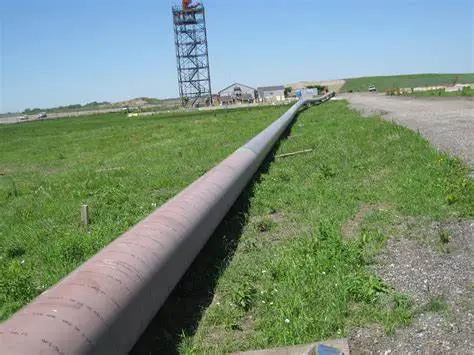
- Applicazioni marine: Pipe jacketing is employed in marine applications, including ships, offshore platforms, and port facilities. It helps protect the pipes from saltwater corrosion and provides insulation for fluid transportation systems on vessels.
- Architectural and Building Applications: Pipe jacketing is utilized in architectural and building applications where pipes need to be aesthetically pleasing. Stainless steel, aluminum, or PVC jacketing materials with various finishes and colors can enhance the visual appearance of pipes in commercial buildings, hotels, restaurants, and other public spaces.
- Commercial Buildings: Pipe jacketing is commonly used in commercial buildings for HVAC systems, plumbing, and fire protection systems. It ensures energy efficiency, thermal insulation, and mechanical protection for the pipes within the building infrastructure.
- Hotels, Restaurants, and Public Spaces: In hospitality and public spaces, pipe jacketing is employed for both functional and aesthetic purposes. It helps maintain the thermal integrity of the piping systems while also contributing to the overall design and ambiance of the space.
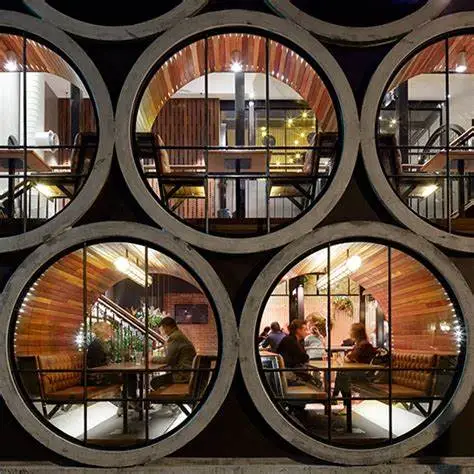
- Industrial Environments: Pipe jacketing is crucial in industrial environments where pipes are exposed to heavy machinery, high temperatures, and harsh conditions. It provides mechanical protection, insulation, and corrosion resistance, ensuring the durability and performance of the piping systems.
- Underground Piping Systems: Pipe jacketing plays a vital role in underground piping systems, such as sewer lines, water mains, and utility pipelines. It protects the pipes from soil corrosion, moisture ingress, and mechanical damage caused by external factors.
- Outdoor Piping Systems: Outdoor piping systems, including those used in irrigation, drainage, or outdoor utilities, require pipe jacketing for weatherproofing and protection against UV radiation, rain, snow, and extreme temperature fluctuations.

Factors to Consider in Pipe Jacketing
Several factors should be considered when selecting and implementing pipe jacketing for a specific application. These factors ensure that the chosen jacketing materials and techniques meet the requirements and challenges of the system. The key factors to consider in pipe jacketing are:
- Temperature Range: The temperature range of the fluid or gas flowing through the pipes is a critical factor. Different jacketing materials have varying temperature tolerances, and selecting the appropriate material ensures the insulation and protection remain effective under the operating conditions.
- Environmental Factors: Environmental factors such as humidity, moisture levels, exposure to chemicals, and atmospheric conditions should be considered. These factors affect the choice of jacketing materials, corrosion resistance requirements, and weatherproofing capabilities.
- Chemical Exposure: In applications where pipes come into contact with corrosive chemicals, the jacketing material must have high chemical resistance. Compatibility with the specific chemicals is crucial to prevent degradation or corrosion of the jacketing material and maintain the integrity of the piping system.

- Aesthetic Requirements: For architectural or building applications, the aesthetic requirements should be taken into account. The choice of jacketing material, finish, color, and texture should align with the desired visual appearance and design intent.

- Budget Considerations: Budget constraints play a significant role in the selection of jacketing materials and techniques. It is essential to balance the desired performance, longevity, and aesthetics with the available budget to ensure cost-effectiveness.
- Consulting with Professionals: Consulting with professionals, such as engineers, contractors, or experienced jacketing specialists, is highly recommended. Their expertise can help in evaluating the specific requirements of the application, selecting suitable jacketing materials, and ensuring proper installation techniques.

Installation Process of Pipe Jacketing
The installation process of pipe jacketing involves several steps to ensure proper insulation, protection, and integrity of the system. While the specific installation techniquesmay vary depending on the jacketing material and application, the general process typically includes the following steps:
- Measurement and Sizing: Accurate measurement of the pipe dimensions is crucial to ensure the jacketing material fits properly. The outer diameter, length, and any fittings or protrusions on the pipe should be measured to determine the required size of the jacketing material.
- Preparation of Pipes: Before installing the jacketing, the pipes should be cleaned and prepared. This may include surface cleaning to remove dirt, grease, or rust. Any existing insulation or coatings that may disturb with the jacketing installation should also be removed.
- Application Techniques: There are various techniques for applying pipe jacketing, depending on the material and system requirements. Some common application techniques include:
- Adhesives: Adhesives, such as contact adhesives or adhesive tapes, are used to secure the jacketing material to the pipe surface. The adhesive is typically applied to the back of the jacketing material, and the material is wrapped tightly around the pipe.
- Mechanical Fasteners: Mechanical fasteners, such as screws, bands, or straps, can be used to secure the jacketing material in place. They offer extra support and make sure a tight fit. This method is commonly used for metal jacketing materials.

- Heat-Shrink Bands: Heat-shrink bands or sleeves are used with heat-shrinkable jacketing materials. The sleeve is placed around the pipe, and heat is applied to shrink the material and create a tight fit.
- Sealing and Insulation Integrity: Proper sealing of joints, seams, and connections is necessary to keep insulation integrity. Sealants or tapes may be used to make sure airtight and moisture-resistant seals. This step helps prevent heat transfer, moisture ingress, and corrosion.
- Vapor Barriers:
- Vapor barriers are used to prevent moisture condensation on the pipe surface. They are typically installed between the pipe and the jacketing material to create a moisture-resistant barrier.
- Weatherproofing:
- For outdoor applications, weatherproofing measures, such as waterproof tapes or coatings, may be applied to protect the jacketing material from UV radiation, rain, and other environmental elements.
- Cladding:
- In architectural applications, cladding materials, such as decorative covers or panels, may be installed over the pipe jacketing to enhance aesthetics and blend with the surrounding design elements.

In conclusion, pipe jacketing plays a vital role in various industries and applications. It provides thermal insulation, corrosion protection, and mechanical integrity to piping systems. By considering factors such as temperature range, environmental conditions, chemical exposure, aesthetics, budget, and consulting with professionals, the appropriate pipe jacketing can be selected.
The installation process involves accurate measurement and sizing, preparation of pipes, application techniques such as adhesives, mechanical fasteners, or heat-shrink bands, sealing and insulation integrity, and the use of additional accessories like vapor barriers, weatherproofing, and cladding.
Pipe jacketing offers numerous benefits, including energy efficiency, system durability, extended service life, reduced maintenance costs, and improved safety. Its diverse applications range from HVAC systems, process piping, and refrigeration systems to chemical plants, oil and gas pipelines, marine applications, and architectural and building projects.
Considering the complexity and criticality of pipe jacketing, professional assistance from engineers, contractors, or jacketing specialists is highly recommended to ensure proper selection, installation, and performance of the jacketing system.


